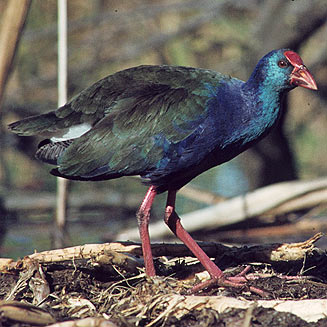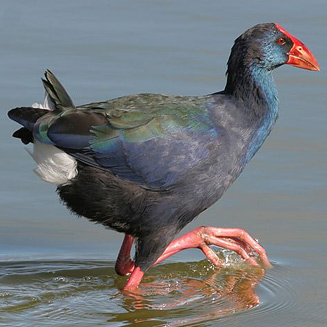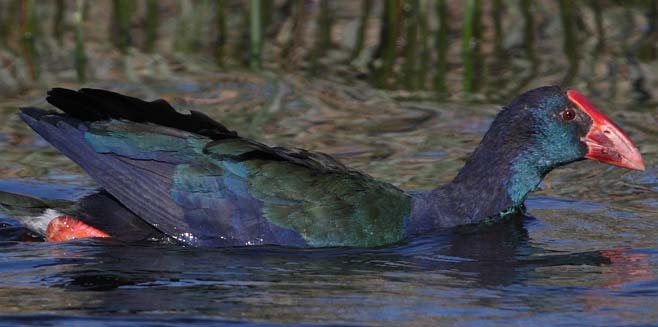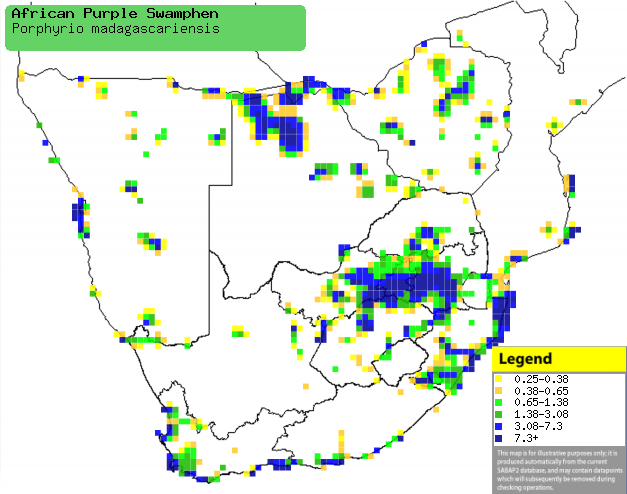|
Porphyrio madagascariensis (African
purple swamphen, Purple gallinule)
[= Porphyrio porphyrio]
Grootkoningriethaan [Afrikaans]; Edenene (generic term for gallinules and
moorhens) [Kwangali]; Nhapata (generic name for coot, gallinule, moorhen,
crake or rail) [Shona]; Purperkoet [Dutch]; Talève d'Afrique [French];
Purpurhuhn [German]; Caimão-comum [Portuguese]
Life
> Eukaryotes >
Opisthokonta
> Metazoa (animals) >
Bilateria >
Deuterostomia > Chordata >
Craniata > Vertebrata (vertebrates) > Gnathostomata (jawed
vertebrates) > Teleostomi (teleost fish) > Osteichthyes (bony fish) > Class:
Sarcopterygii (lobe-finned
fish) > Stegocephalia (terrestrial
vertebrates) > Tetrapoda
(four-legged vertebrates) > Reptiliomorpha > Amniota >
Reptilia (reptiles) >
Romeriida > Diapsida > Archosauromorpha > Archosauria >
Dinosauria
(dinosaurs) > Saurischia > Theropoda (bipedal predatory dinosaurs) >
Coelurosauria > Maniraptora > Aves
(birds) > Order: Gruiformes >
Family: Rallidae
 |
 |
| African purple swamphen. [photo H.
Robertson ©] |
Rondevlei Bird Sanctuary, South Africa. [photo
Trevor Hardaker ©] |
 |
| African purple swamphen swimming near
a flooded reedbed, Rondevlei Bird Sanctuary, South Africa. [photo
Duncan Robertson
©] |
Distribution and habitat
Occurs across sub-Saharan Africa,
including southern Africa, where it is locally common in northern and eastern
Botswana, patches of Namibia, Zimbabwe, the coast of Mozambique and South Africa,
largely excluding the Northern Cape and the interior of the Eastern Cape. It
generally prefers freshwater or brackish ponds, sluggish rivers flanked by reeds
(Phragmites) and sedges, marshes, swamps and seasonally flooded wetlands.
|
 |
|
Distribution of African purple swamphen in
southern Africa, based on statistical smoothing of the records from
first SA Bird Atlas Project (©
Animal Demography unit, University of
Cape Town; smoothing by Birgit Erni and Francesca Little). Colours range
from dark blue (most common) through to yellow (least common).
See here for the latest distribution
from the SABAP2. |
Call
Predators and parasites
Movements and migrations
Mainly resident and
sedentary, although it moves away from seasonally inundated areas
(such as the Nyl River flood plain, South Africa) in the dry season.
Food
Omnivorous, mainly eating
plant matter supplemented with invertebrates, frogs, fish, carrion and bird eggs
and nestlings. It does most of its foraging by clambering around low vegetation,
biting off plant stems and looking underneath floating vegetation for
invertebrates. The following food items have been recorded
in its diet:
-
Plant matter
-
roots
-
stems
-
leaves
-
flowers
-
seeds
-
tubers
-
Animals
-
invertebrates
-
insects
-
snails
-
worms
-
leeches
-
crabs
-
vertebrates
-
frogs and their eggs
-
fish and their eggs
-
carrion
-
bird eggs and nestlings
Breeding
-
Monogamous, facultative cooperative breeder, meaning that
the breeding pair are assisted by helpers. The male vigorously defends his
territory by fighting and displaying to intruders.
-
The nest is built by the female with material provided by
the male, consisting of a bulky, shallow cup of reeds, bulrushes, grass, and
other water plants, sometimes lined with papyrus (Cyperus), grass
leaves and flower heads or ferns.
-
Egg-laying season is from July-January, peaking from
August-March.
-
It lays 2-5 eggs, which are incubated mainly by the female,
although assisted by the male and helper, for about 23-27 days.
-
The chicks leave the nest soon after hatching, and are cared for
by both parents and helpers, taking their first flight at approximately
eight weeks old.
Threats
Not threatened, although its
numbers are decreasing locally due to disturbance, wetland drainage and removal
of riparian vegetation.
References
-
Hockey PAR, Dean WRJ and Ryan PG 2005. Roberts
- Birds of southern Africa, VIIth ed. The Trustees of the John Voelcker
Bird Book Fund, Cape Town.
|
